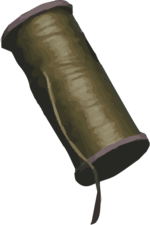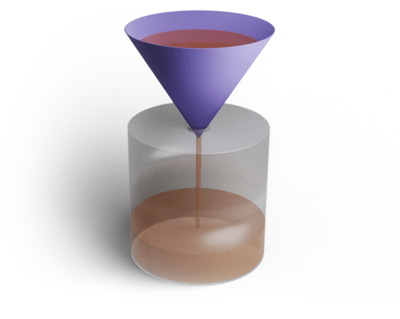Sign In
Modeling in Three Dimensions
| | 8 Theory slides |
| | 9 Exercises - Grade E - A |
| | Each lesson is meant to take 1-2 classroom sessions |
Catch-Up and Review
Here are a few recommended readings before getting started with this lesson.
Comparing Aquarium Volumes

Comparing Aquarium Volumes II
Recall how the formula for the volume of a sphere is proven. The same thought process used in the proof can be applied to solve the challenge.
Two types of aquariums attract the attention of Dominica: Aquarium A and Aquarium B.

Hint
Solution
| Volume of the Cylinder | Volume of the Cone | |
|---|---|---|
| Formula | V1=πr2h | V2=31πr2h |
Both the cone and the cylinder forming Aquarium A have a 10 foot diameter, and therefore both have a radius of 5 feet. With that in mind, substitute r=5 and h=5.
| Volume of the Cylinder | Volume of the Cone | |
|---|---|---|
| Formula | V1=πr2h | V2=31πr2h |
| Substitute Values | V1=π(5)25 | V2=31π(5)25 |
| Calculate | V1=125π | V2=3125π |
V1=125π, V2=3125π
a=33⋅a
Subtract fractions
Use a calculator
Round to nearest integer
Aquarium A
Since the cone inside the aquarium is a right cone, its vertex is directly above the center of its base. Furthermore, its height and radius have the same length. Therefore, an isosceles right triangle inside the cone can be formed, as indicated in the diagram.

Substitute values
Calculate power
Commutative Property of Multiplication
(a−b)2=a2−2ab+b2
Distribute -π
Subtract term
Aquarium B
Examine the vertical cross-sections of the hemisphere.
AB=5−h, AC=5
LHS−(5−h)2=RHS−(5−h)2
Calculate power
(a−b)2=a2−2ab+b2
Distribute -1
Subtract term
LHS=RHS
a2=a

|
Cavalieri Principle |
|
Two solids with the same height and the same cross-sectional area at every altitude have the same volume. |
Both aquariums have a height of 5 feet, and the area of the water’s surface when filled to a height of h feet is the same for each aquarium.
| Aquarium A | Aquarium B | |
|---|---|---|
| Height (ft) | 5 | |
| Cross-Sectional Area (ft2) | 10πh−πh2 | |
Finding the Length of a Toilet Paper Roll
Tiffaniqua wants to calculate the length of the a toilet paper roll. Hey! It is on a great sale, Okay. She draws a diagram and denotes the thickness of the paper, the inner radius, and the outer radius by t, r, and R, respectively.

Solution


Cylindrical Soda Can
A cylindrical soda can is made of aluminum. It is 6 inches high and its bases have a radius of approximately 1.2 inches.

Give a go at answering the following set of questions. If necessary, round the answer to two decimal places.
Hint
Solution
a⋅cb=ca⋅b
Cross out common factors
Simplify quotient
Multiply
Choosing Type of Glass
By modeling real-life objects using geometric shapes, various characteristics of the objects can be determined. These characteristics can then be compared to make inferences which could impact real decisions to be made.
Emily is attending a fair and wants to sell 1.5 liters of homemade orange juice she is naming Oranjya Thirsty. She needs to decide the type of glass she will use to serve the juice — a cocktail glass or a Collins glass.

A cocktail glass is a type of glass that has an inverted cone bowl. The cone bowl's height is 5.8 centimeters and the radius of its base is 5.4 centimeters. A collins glass is a cylindrical glass with a height of 9 centimeters and a radius of 3.2 centimeters. Help Emily make a decision by answering the following questions.
Hint
Solution

r=5.4, h=5.8
Calculate power
Multiply
b1⋅a=ba
Use a calculator
Round to nearest integer

| Type of Glass | |
|---|---|
| Cocktail Glass | Collins Glass |
| 8⋅6 | 5⋅10 |
| $48 | $50 |
Estimating How Many Grains of Sand a Hand Can Hold
Take, for example, Ramsha's situation. She is looking through photos from her trip to the beach to post on her social media page. A photo that shows her holding sand sparks her curiosity. She wonders how many individual grains of sand is she holding. Ramsha thinks she can model a grain of sand using a sphere. She then assumes that each grain has a diameter of 0.06 centimeters.

Answer
About 1.7×106
Hint
The formula for the volume of a sphere is V=34πr3, where r is the radius of the sphere.
Solution
Finding the Volume of a Grain
The radius of a grain is 20.06=0.03 centimeters. Use the formula for the volume of a sphere to find the volume of a grain.r=0.03
Calculate power
Commutative Property of Multiplication
ca⋅b=ca⋅b
Use a calculator
Round to 5 decimal place(s)
Write in scientific notation
Finding the Mass of a Grain
The density of a grain is 1.52g/cm3 and its volume is 1.1×10-4 cubic centimeters. By multiplying these values, the mass of a grain can be found.ca⋅b=ca⋅b
Cancel out common factors
Simplify quotient
Commutative Property of Multiplication
Multiply
Round to 1 decimal place(s)
Finding the Number of Grains
Finally, substitute the values into the formula mentioned at the beginning to calculate the number of grains of sand.M=300g, m=1.7×10-4g
Cross out common factors
Simplify quotient
Write as a product of fractions
am1=a-m
Calculate quotient
Multiply
Round to 2 significant digit(s)
Write in scientific notation
the total number of stars in the universe is greater than all the grains of sand on all the beaches of the planet Earth.
Modeling the Human Eye
Research projects usually require an interdisciplinary approach. That is, people from different disciplines work together to develop and test hypothesis, run experiments, and test theories.
Biologists, for example, can work with mathematicians to model a part of an organism. By doing so, researchers can predict how these parts function, grow, and change. For example, the human eye was able to be modeled as a sphere. Move the slider to rotate the eye.

Diego is making a cube out of 64 meters of copper thread which he is melting down. The thread is cylinder-shaped with a diameter of 16 millimeters. What will the cube's side s be in centimeters? Provide the amount in exact form.
To determine the cube's side, we must first find its volume. This is the same as the volume of the copper thread. From the exercise, we know that the thread is cylinder-shaped with a diameter of 16 millimeters and a length, or height, of 64 meters.
Therefore, we must use the formula for calculating the volume of a cylinder. V=π r^2 h Notice that the radius and height have different units of measurement. Before calculating the volume of the thread, we must convert between units.
Converting Between Units
Since its easier to work with nondecimal numbers, we will convert the cylinder's height to millimeters. In one meter, we have 1000 millimeters. This gives us the following conversion factor. 1000 mm/1 m Now we can convert 64 meters to millimeters.
The height of the cylindrical thread is 64 000 millimeters.
Volume of the Thread
Since both dimensions of the thread is in the same unit, we can determine its volume. Notice that the thread's diameter is 16 millimeters, which means it has a radius of 8 millimeters.
The volume of the thread, and therefore the cube, is 4 096 000π cubic millimeters.
Side of the Cube
Recall that the volume of a cube is the cube of its side s. V=s^3 Now we can determine the side of the cube that Diego can form. To do so, we will substitute the volume of the thread into the above formula and solving for s.
The side of the cube is 160sqrt(π) millimeters, which can be converted to centimeters by multiplying the conversion factor of 1 cm10 mm. 160sqrt(π) mm * 1 cm/10 mm = 16sqrt(π) cm The cube that Diego can get at the end has sides of length 16sqrt(π) centimeters.
Dominika is building a sauna in her backyard. The sauna's floor will be in the shape of a square and have a base area of 10 square meters. The sauna's walls will be 2 meters high.
We know that the floor is a square with an area of 10 square meters. Therefore, we can calculate its side length by using the formula for the area of a square. A=s^2 Let's substitute the area of the floor into the equation and solve for s.
The sauna can be viewed as a composite solid, consisting of a rectangular prism and a triangular prism sitting on top of it.
From the given information, we know that the height of the sauna equals the length of sides of the sauna's base, which we calculated in the first section to be sqrt(10) meters. Since we also know the walls of the sauna are 2 meters high, we can determine the dimensions of the composite solid.
We can now find the volume of each prism, and thus the volume of the composite solid.
Volume of the Rectangular Prism
Recall that the volume of a rectangular prism is the product of its length l, width w, and height h. From the diagram, we know that l = sqrt(10), w = sqrt(10), and h= 2. Let's calculate the volume.
Volume of the Triangular Prism
The volume of the triangular prism is the product of its base area and the prism's height. V_(TP) = Bh From the diagram, we see that the triangle has a height of (sqrt(10)-2) meters and a base of sqrt(10) meters. Therefore, we can calculate the area of the base B. B = 1/2(sqrt(10))(sqrt(10)-2) We also see that the height of the prism is sqrt(10) meters. Now we can calculate the volume.
Volume of Sauna
Now we will add the volume of the the two prisms to determine the total volume of the Sauna.
The volume of the sauna will be about 26 cubic meters.
A shop is selling cone-shaped cartons filled with cherry juice. Tiffaniqua makes a hole at the bottom of the cone and pours the juice it into a cylinder-shaped container. The cone's inner radius is 90% of the cylinder's inner radius. The cone's height is 80% of the cylinders height.
What percent of the cylinder gets filled? Round to the nearest percent.From the exercise, we know that a shop sells cherry juice in cone-shaped cartons. Therefore, we should start by finding an expression for the volume of the cone.
Volume of the Cone
Let's recall the formula for the volume of a cone. V=1/3π r^2 h We have not been given the radius or the height of the cone. However, we do know its radius and height in relation to the cylinder. If we call the cylinder's height and radius H and R, and the cone's height and radius h and r, we can write the following equations. 90 % ofR&=r ⇔ 0.9R=r 80 % ofH&=h ⇔ 0.8H=h Now, we can write an expression for the cone's volume.
This expression shows the volume of the cone in terms of the cylinder's height H and radius R.
Volume of the Cylinder
The volume of a cylinder is calculated by using the following formula. V=π r^2 h Remember that we defined the radius and diameter of the cylinder as R and H. This means we can express the volume of the cylinder in the following way V=π R^2 H
Calculating the Percentage
We have written expressions for the volume of the cherry juice and the volume of the cylinder. We can now divide the volume of the cherry juice by the volume of the cylinder to determine what percentage of the cylinder is filled.
About 22 % of the cylinder-shaped container is filled with the cherry juice.


